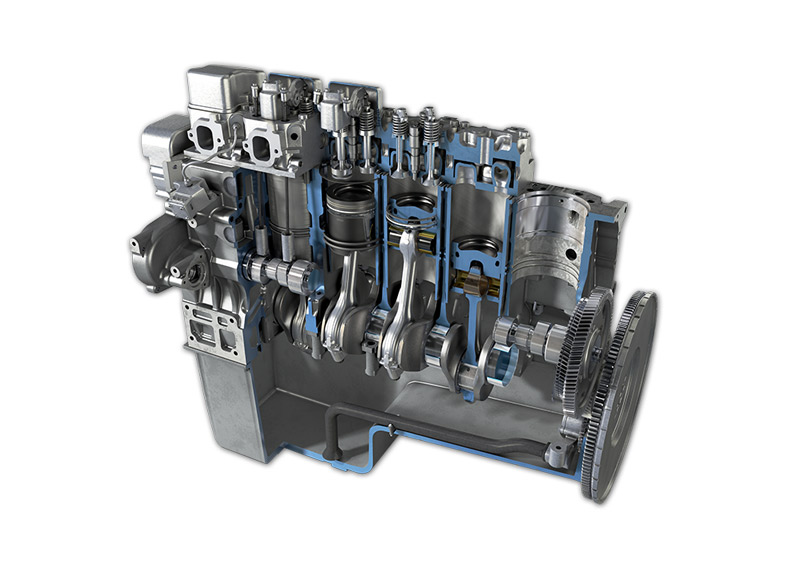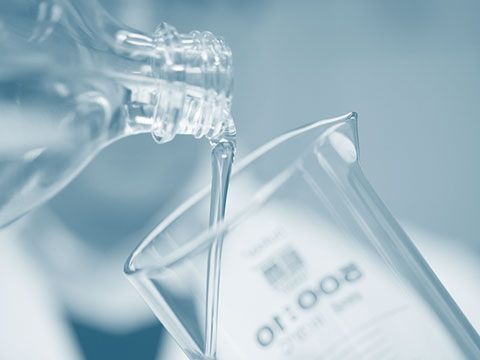Petrol Engine
The petrol engine remains the most widely used engine in passenger vehicles. By burning fuel, it converts chemical energy into thermal energy, which is then transformed into mechanical energy via pistons to drive the vehicle.
Function
Like other internal combustion engines, the petrol engine converts chemical energy into motion, friction, and heat through combustion. It operates using petrol.
During operation, the pressure generated by the combustion of an air/fuel mixture acts on the pistons, causing them to move up and down. This movement is transferred via a crank mechanism, consisting of connecting rods and a crankshaft, which converts the linear motion into rotational motion, ultimately driving the vehicle's wheels. Compared to the diesel engine, the petrol engine differs in its compression and ignition process. While a diesel engine relies on self-ignition due to high compression, petrol engine requires a spark plug for ignition (external ignition).
Operating Principle
A petrol engine operates on the four-stroke cycle, which consists of intake, compression, combustion, and exhaust.
- Intake stroke:
The air/fuel mixture enters the cylinder through the open intake valve. - Compression stroke:
The intake valve closes, and the mixture is compressed. - Power stroke:
The spark plug ignites the mixture, generating expanding gases that push the piston downward. - Exhaust stroke:
The burned gases exit the combustion chamber through the open exhaust valve. The cycle then repeats continuously as long as the engine is running.
Structure
The petrol engine is a complex mechanical system composed of several key components.
Engine block & crankcase
The engine block houses the cylinders, where the pistons move up and down. It is usually made of cast iron or aluminium and serves as the engine’s foundation.
Cylinders & pistons
Each cylinder contains a piston, which moves up and down. The pistons are connected to the crankshaft via connecting rods.
Crankshaft
This central component converts the linear movement of the pistons into rotational motion. The energy generated by combustion is transferred through the connecting rods to the crankshaft, which then drives the vehicle’s transmission.
Valve system
The intake and exhaust valves regulate the flow of air and exhaustes in and out of the cylinders. These valves open and close in sync with the engine cycle to ensure proper combustion and emissions control.
Cooling & lubrication system
These systems maintain optimal engine temperature and reduce friction between moving parts. Coolant circulates through the engine to dissipate heat, while oil lubricates moving components.
Safety
Modern petrol engines are equipped with various control and safety features. Electronic control units precisely regulate fuel injection and supply, ensuring efficient operation and emissions control. A key safety feature is the rev limiter, which prevents the engine from exceeding its maximum RPM, protecting it from damage. Another important function is oil pressure monitoring through an oil pressure sensor. If the oil pressure drops too low, the engine shuts down automatically to prevent damage due to insufficient lubrication.
Environmental Impact
Significant advances have helped reduce emissions from petrol engines. These include catalytic converters, particulate filters, direct fuel injection, and turbocharging. The gas exchange process in four-stroke engines greatly affects performance, fuel consumption, and emissions. Advanced engine management systems use multiple sensors to optimise fuel injection timing and quantity, ensuring ideal combustion for the proper functioning of catalytic converters and particulate filters.
Many modern petrol engines feature an automatic start-stop system, which turns off the engine when the vehicle stops at a traffic light or in traffic, to save fuel and reduce emissions. The engine restarts automatically when the accelerator pedal is pressed or the brake pedal is released. These technologies help petrol engines meet strict emission regulations and contribute to reducing environmental impact.
Petrol engines are often integrated into hybrid powertrains, where they work in combination with an electric motor.
Value Retention
Regular maintenance is essential for petrol engines. Routine oil changes and replacement of wear parts such as spark plugs and air filters help extend engine life. Using high quality fuel and adopting proper driving habits can further reduce engine wear and maintain performance.









